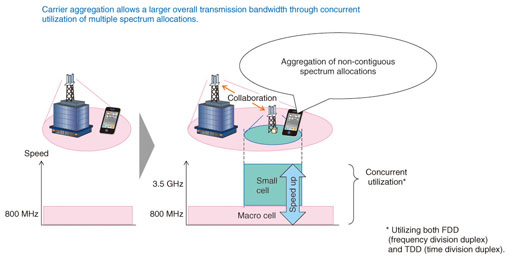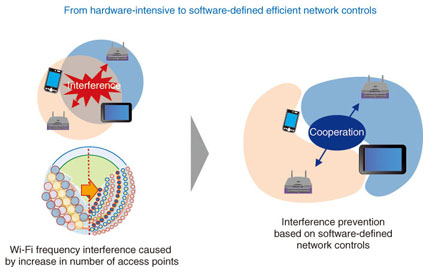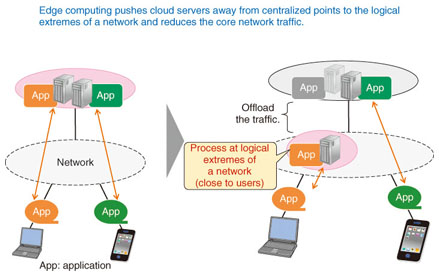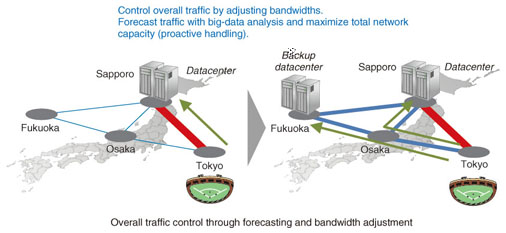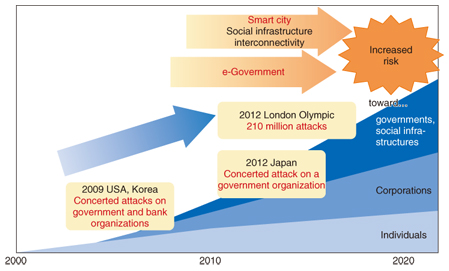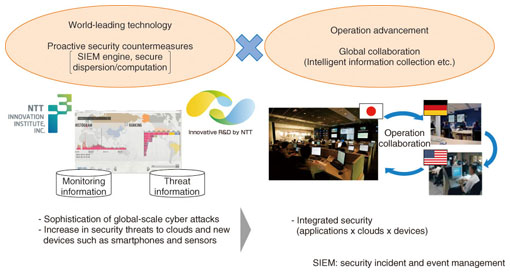 |
|
|
|
|
|
Feature Articles: Keynote Speeches at NTT R&D Forum 2014 Vol. 12, No. 4, pp. 1–8, Apr. 2014. https://doi.org/10.53829/ntr201404fa1  Accelerating Innovation and Collaboration for the Next StageAbstractThis article introduces a vision for new services to be achieved by 2020 and the technical challenges taken on by the NTT Group to provide behind-the-scenes support. The content of this article is based on the keynote lecture presented by NTT President and CEO Hiroo Unoura at NTT R&D Forum 2014 held on February 13–14, 2014. Keywords: innovation, collaboration, cloud 1. Towards the Next StageNTT’s Medium-Term Management Strategy announced in the fall of 2012 can be summarized by its subtitle “Towards the Next Stage.” In this regard, we are all delighted that Japan will host the “Big Event” in 2020, and I believe that this Big Event is making the “next stage” easier to visualize while clarifying targets for our business development schedule. The key concept of our Medium-Term Management Strategy is “value partner.” For NTT, the time has come to shift from a business-to-consumer (B2C) model of selling lines and terminals to a cloud-based business model. In this shift, we aim to support a business-model transformation among our corporate customers and the creation of enriched lifestyles among our individual customers. It is in this sense that we use the term “value partner.” There are a number of major currents in the field of information and communication technology (ICT) in relation to global, cloud, and mobile technologies, and there are many and varied players in this field. While it may appear to be a highly competitive era, I personally believe that we have entered an era of cooperation and collaboration. In a cloud or global era, customers can freely select their services. It therefore stands to reason that being competitive in such an era means the ability to be continually selected by our customers. In short, the essence of being competitive is not getting a customer to buy something just once but in retaining that customer for a long period of time. To become the value partner that customers continue to select, I believe it is extremely important that we have cooperative and collaborative abilities to promote new businesses with a variety of players. 2. The year 2020A number of interesting forecasts have been made in relation to 2020, as shown in Fig. 1. First of all, while the gross domestic product (GDP) looks as if it will pick up steam in China and emerging countries, Japan at the center of this figure is marked with a small circle. This forecast was made by a variety of researchers before the decision was made about the 2020 Big Event. I would therefore like to use the Big Event as an opportunity to do what we can to make Japan’s circle a bit larger.
In addition, Japan is predicted to lead the world as an aging society. The number of terminals connected to the Internet, meanwhile, is expected to reach 30−50 billion, which is 10 times the current number. It is also said that Japan’s quasi-zenith satellite system will be in full-scale operation by 2020. The first satellite of this system was launched in 2010, and the plan is to launch three more satellites by 2019. This system will make it possible to achieve highly accurate positioning as fine as several centimeters. I would like to consider with everyone here how these changes in the present might affect business in the future. 3. Smart life and smart work 2020In the world of 2020, a variety of services will be built on and enabled by clouds (Fig. 2). I believe that linking and coordinating multiple clouds will lead to new services and business models.
Take transportation, for example. Linking the clouds of the bus, subway, airplane, and taxi industries could lead to an advanced intelligent transport system (ITS). In other words, linking clouds in this way can open up a new world in a certain sector, but what would happen if transportation is linked with the clouds of other industries? I will address this question next. 3.1 Tourism: navigation × translationHere, I will introduce services that come about by linking technologies associated with transportation with those of tourism, navigation, and translation. To begin with, we can envision a travel service that begins when you use a smartphone to take a picture of your train station’s symbol or mark and then a picture of your destination from a travel magazine or similar. You could then receive information on this trip from the station to the destination in the language that you previously set as well as information on sightseeing spots, restaurants, etc., at the destination. It was recently reported in the news that the Japanese government has issued guidelines calling for the installation of multilingual information boards in train stations. This could result in the preparation of relatively large boards in many languages, but using a smartphone would make such multilingual boards unnecessary since receiving information in your mother tongue could be achieved by simply taking a picture. I think a world with such services will be a reality by 2020. Let me introduce such a service that has already been achieved within the NTT Group. This is PictuAR, which was developed and commercialized by NTT COMWARE (Fig. 3). With this service, a user who uses his or her smartphone to capture a photo that includes the PictuAR symbol will see that photo come alive as a video on the smartphone screen. For example, capturing a photo of a restaurant with the PictuAR symbol results in a video display of recommended menu items or views of the restaurant’s interior.
3.2 Entertainment: video × sportsI would now like to take a look at a world of entertainment that links sports and video. For sports such as soccer or baseball, a service could make it possible for the viewer to observe play from an athlete’s view, from the manager’s or coach’s view, or from an overhead position, or to combine a view with data on individual athletes. This kind of service could be implemented on smartphones and tablets. It is already being tested in the United States, and steps are being taken toward its commercialization. There has been much talk about the convergence of communications and broadcasting, but if we consider the potential of collaboration between broadcasters and stadium owners or baseball teams, perhaps that convergence will evolve in unexpected ways. 3.3 Innovation through service collaborationAs I mentioned, new services can be developed by tying together a variety of services (Fig. 4). It was just announced the other day that Toray Industries and NTT had collaborated on the development of a smart shirt that can be used to obtain an electrocardiogram of the wearer. This is a good example of a collaborative effort between the apparel and IT (information technology) industries the likes of which have not been seen before. Imagining that such tie-ups and collaborative efforts continue to take place, I think new worlds will be drawn, which will lead to the creation of a new Japanese business model for the future.
Japan and the United States have often been compared with reference to the word “innovation.” In the United States, old legacy systems can be replaced relatively easily, but in Japan, it is more difficult. For this reason, I believe that innovation through collaboration provides a convenient shortcut for Japanese-style innovation, service development, and business-model creation. Looking forward, technologies and services that support the linking of ICT infrastructures and the linking of clouds will be needed to promote various types of collaboration between services and enterprises. I believe that NTT R&D can make a contribution to this end and that a new business-to-business (B2B) model of NTT Group can be applied here. 4. NTT Group challenges toward 2020I have talked about the possibility of creating a new business model through collaboration. Of course, we will continue to face a number of challenges both as a player participating in new markets and as a value partner opening up new markets. In the following, I would like to introduce two major challenges for NTT as a telecommunications carrier toward 2020. 4.1 Challenge 1: Network controlsVarious predictions have been made, but I think I can safely say that the volume of information passing through our network and those of other players will increase substantially by 2020. By the way, a report from British Telecom stated that network traffic in the vicinity of venues of the London Olympics increased by seven times over that of the Beijing Olympics held four years earlier, so we can only wonder how traffic might further increase at the Rio de Janeiro Olympics, and for that matter, at the Tokyo Olympics four years after that. If traffic simply continues to increase by seven times in this way, we would get 7 × 7 = 49 times the amount of information. How can such an ever-increasing amount of traffic be controlled? This is the first challenge for the NTT Group, and I introduce here four technologies that we plan to deploy to meet this challenge. (1) Carrier aggregation Carrier aggregation technology will enable the simultaneous use of multiple spectrum allocations (Fig. 5) while accommodating both time division duplex (TDD) and frequency division duplex (FDD) wireless communications. In the future, we expect carrier aggregation to enable even higher transmission speeds by simultaneously using a number of spectrum allocations including Wi-Fi.
(2) Software-defined wireless network If we were to attempt to deal with an increase in traffic that is several tens of times the current levels by simply adding more hardware, we would need an enormous number of new facilities. Likewise, if we were to simply increase the number of Wi-Fi base stations at stadiums and other venues, the resulting high-density configuration would generate mutual interference among those stations. In short, relying solely on a hardware solution has its limits. In contrast, base-station coordination by using software controls can reduce mutual interference and provide a comfortable wireless communications environment (Fig. 6).
(3) Edge computing Edge computing is a technology that can reduce traffic in the relay network by placing cloud servers closer to users and performing distributed processing (Fig. 7). It can also minimize delay by shortening the distance between servers and terminals. Let’s consider traffic conditions at the opening ceremony for the 2020 Big Event, when about 80,000 people will be walking around with their smartphones and tablets in the main stadium. To handle this traffic, we will need to implement distributed processing by edge computing and direct the flow of traffic through storage facilities at locations close to terminals.
(4) Proactive wide-area traffic controls Wide-area traffic controls provide a means of adjusting bandwidths to control the overall traffic on the network (Fig. 8). Let’s assume, for example, that a datacenter hosting cloud systems related to the 2020 Big Event is located in Sapporo. We can expect the traffic to be heavily concentrated during the period of the 2020 Big Event. This technology will predict that traffic at the Sapporo datacenter will become congested at that time and will automatically perform distributed processing at a backup datacenter in Fukuoka. In other words, it will proactively respond before that congestion has a chance to negatively affect overall cloud services. I believe that this kind of technology for achieving wide-area traffic controls will be an absolute necessity by the time of the Big Event.
4.2 Challenge 2: Integrated securityAbout 210 million attacks were mounted on the official website of the 2012 London Olympics, and while British Telecom managed to fight off those attacks without incident, we can imagine that by 2020, attacks will be mounted on a more sophisticated level. In a world in which almost all services are migrating to clouds, including those provided by financial institutions and smart cities, the risk to society is increasing (Fig. 9). We can assume that attackers will mount attacks by taking advantage of various vulnerabilities in networks and clouds. How then can we deal with the increased risk to society? This is also a major challenge for the NTT Group.
The NTT Group is developing world-leading technologies to counter these increasingly sophisticated attacks (Fig. 10). For example, NTT Communications is already coordinating security operations on a global scale, but coordinated operations that include overseas carriers and IT vendors will also be necessary. We can think of this as collaboration between security operations. As clouds become increasingly linked in the future, it will become impossible for the NTT Group to implement a complete set of security measures by itself. It will therefore be necessary to defend against increasingly sophisticated attacks by coordinating operations with a variety of players and even other competitors in the same industry. NTT R&D has a strong security team for dealing with such attacks, and NTT Innovation Institute, Inc. (NTT I3), founded in the spring of 2013, is also preparing a range of products that incorporate advanced security technologies developed in the United States.
5. NTT Group future activitiesTrusted relationships between partners are a major source of collaborative abilities. For this reason, I changed the words “total solutions” to “trusted solutions,” so that “Next Value Partner for Transformation by Total Solutions” became the more meaningful “Next Value Partner for Transformation by Trusted Solutions.” Instead of being a corporate group that simply functions as a provider as we have been so far, the NTT Group has its eye on collaborating with diverse companies and industries and assisting in the creation of new business models. I would like to shift the company toward B2B in this sense. I believe that NTT R&D has the power to function well as a catalyst for collaboration among various industries, enterprises, and services. The year 2020 will be a time when the fundamental strengths of the NTT Group are put to a test in the areas of network controls and security management. Going forward, my aim is to plan the further growth of the NTT Group by overcoming all sorts of trials and challenges through the power of NTT R&D and the business-development abilities of the group companies. |
|













